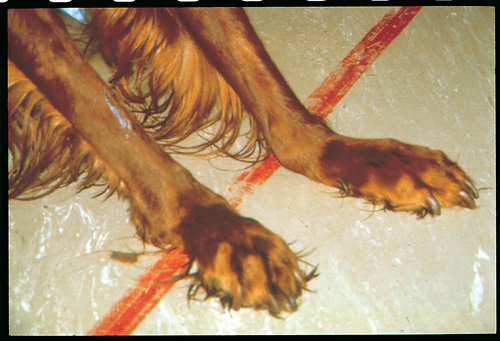Difference between revisions of "Small Animal Orthopaedics Q&A 02"
Ggaitskell (talk | contribs) |
|||
| Line 1: | Line 1: | ||
| + | {{Manson | ||
| + | |book = Small Animal Orthopaedics Q&A}} | ||
| + | |||
[[File:SmAnOrth 02.jpg|centre|500px]] | [[File:SmAnOrth 02.jpg|centre|500px]] | ||
Revision as of 22:16, 23 October 2011
| This question was provided by Manson Publishing as part of the OVAL Project. See more Small Animal Orthopaedics Q&A. |
A photograph of the distal forelimb of a dog that jumped from a 6 m height and acutely developed this deformity.
| Question | Answer | Article | |
| What is the most likely diagnosis? | Bilateral carpal hyperextension injuries. |
[[|Link to Article]] | |
| What pathology is typically associated with this condition | The palmar support for the carpus is derived from a myriad of small ligaments that support the surrounding bones and fibrocartilage. A major misconception is that carpal hyperextension injuries are caused by flexor tendon disruption. The tendon of insertion of the flexor carpi radialis muscle contributes minimally to the stability of the carpus. The main structure supporting the palmar aspect of the antebrachiocarpal joint is a complex of ligaments which connect the distal radius, the distal ulna and the accessory carpal bone to the palmar aspect of the radial carpal bone. The intercarpal joint is also supported by an array of small, unnamed ligaments. The carpometacarpal joint is supported by the strong palmar carpal fibrocartilage, many small ligaments and two strong accessory carpal-metacarpal ligaments. Hyperextension injuries result from disruption of some or all of these anatomic structures. |
[[|Link to Article]] | |
| What radiographic view should be obtained prior to surgical treatment of this conditon? | In addition to dorsopalmar and lateral view radiographs, stress radiographs should be obtained to establish the level(s) of the instability. Stress radiographs are necessary to identify the location of the instability. Standing, cross-table radiographs are obtained with the dog weight-bearing (lifting the ipsilateral limb will increase weight-bearing) using a horizontal beam. If instability is confined to the intracarpal and carpometacarpal joint, a partial carpal arthrodesis may be indicated; however, if there is instability of the antebrachiocarpal joint, a pancarpal arthrodesis should be considered. |
[[|Link to Article]] | |
